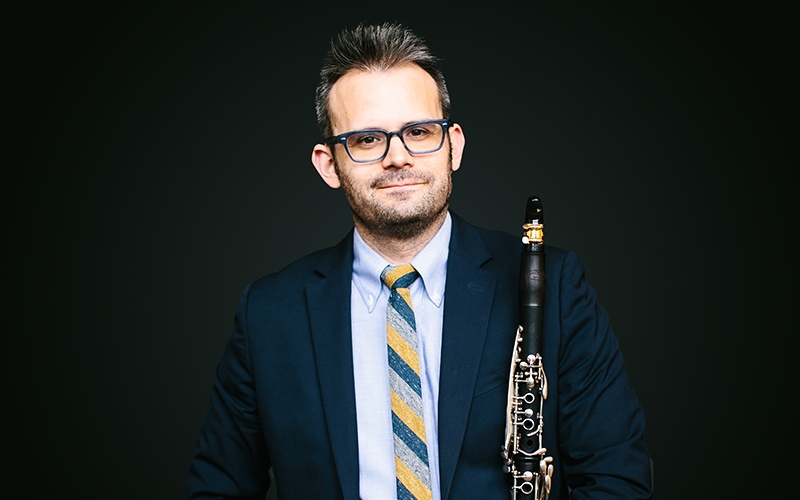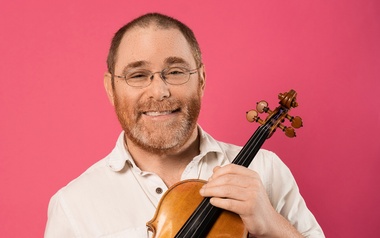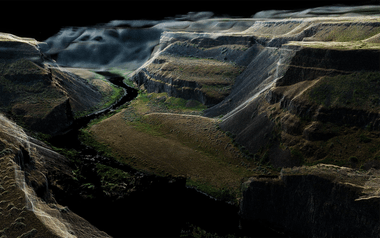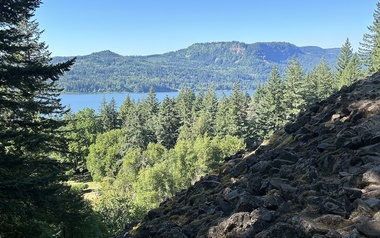Blog
MARCH 13, 2023
Eight Questions for Clarinetist James Shields

On March 23rd, James leads Team 45th Parallel in Illuminations. The program features music of Joan Tower, Andy Akiho, Andrew Norman, and John Luther Adams.
1. Who the hell are you? From whence did you emanate?
I’m still trying to figure out the answer to that first one. To the second question, I spent the first 18 years of my life in Austin, Texas, and I am the son of an astrophysicist and a soprano. My first orchestral job was with the New Mexico Symphony Orchestra in Albuquerque, and following that I spent 5 years in the Canadian Opera Company in Toronto before moving to Portland to join the Oregon Symphony.
2. Where did the idea for Illuminations come from?
Just by chance. I was trying to put together a few programs with pieces that had been suggested by my colleagues in 45th Parallel, along with a few pieces from my own wish list. I noticed that a few of them had titles that referenced light, so I thought I’d run with that.
3. What are the pieces on the program?
The program opens with Andrew Norman’s Light Screens for Flute and String Trio. This energetic and tightly constructed work was inspired by Frank Lloyd Wright’s designs for stained glass windows.
Joan Tower’s Fantasy (…those harbor lights) is an enigmatic work for clarinet and piano. Tower draws her inspiration for the composition from one of her favorite songs, Harbor Lights, a tune written in the 1930s with music by Hugh Williams and lyrics by Jimmy Kennedy. The song was later popularized by the likes of Bing Crosby, Elvis Presley, and Willie Nelson, and the lyrics conjure up images of loss, the harbor lights being used to evoke images of one’s sweetheart being borne away by a ship sent out to sea. Tower uses the open notes and intervals of the popular tune – a major 7th chord – in her work, but she transforms the material into her unique and personal compositional voice from the get-go. What remains is Tower’s version of the yearning, questioning, and sense of loss found in Kennedy’s original lyrics:
I saw the harbor lights
They only told me we were parting
The same old harbor lights that once brought you to me
I watched the harbor lights
How could I help if tears were starting
Goodbye to tender nights beside the silvery sea
I long to hold you near and kiss you just once more
But you were on the ship and I was on the shore
Now I know lonely nights
For all the while my heart is whispering
Some other harbor lights will steal your love from me
I long to hold you near and kiss you just once more
But you were on the ship and I was on the shore
Now I know lonely nights
For all the while my heart is whispering
Some other harbor lights will steal your love from me
When it comes to connections between light and sound, the perceptual phenomenon of synesthesia is one of the most fascinating. In the music business, we are most familiar with sound/light synesthesia, although the term can refer to the linkage of many different types of perceptual and/or conceptual inputs. Composers such as the French composer Olivier Messiaen sense specific colors when they hear sounds or harmonies. Andy Akiho shares the experience of this phenomenon with Messiaen, whose well known Quartet for the End of Time (1941) can be seen as a model for Andy’s Lost on Chiaroscuro Street (2017) in some superficial ways. Both works are scored for clarinet, violin, cello, and piano, and both feature a solo movement for clarinet alone in the center of the composition. Beyond that, Akiho’s deeply original compositional voice is the prime focus of the listening experience. Harmonically inventive and rhythmically fascinating, Andy is able to pull off the rare feat of creating music that is both novel and accessible. Lost on Chiaroscuro Street is a great introduction to Andy’s music for those who are unfamiliar with his musical language.
The final work on the program is John Luther Adams’ The Light that Fills the World. Like “the other John Adams” composing music today, John Luther Adams’ music is sometimes described as minimalist, although don’t expect to be reminded of Steve Reich or Phillip Glass. Adam’s works have an expansiveness and stillness that seem to transcend any sense of ordinary human time scales.
Deeply concerned with the environment and human society’s impact on the planet, Adams works often reference geological scales in ways that are spatial, temporal, and spiritual. In the composer’s own words:
“The Light That Fills the World was written in late winter and early spring when – following the long darkness of winter – the world is still white and filled with new light. If the unrelenting texture of this music embodies stasis, I hope its prevalent tone evokes the ecstatic. The title of the piece is borrowed from an Inuit song which sings of the close relationship between beauty and terror, risk and revelation.”
– John Luther Adams, Fairbanks, Alaska, August 1999
4. What are some of the challenges of preparing this kind of program?
Each piece has a different instrumentation and a different feel, so we’ll need to navigate changing personnel and changing musical pacing throughout the evening. Andy’s piece takes a completely different type of concentration than the Adams, which can be both challenging and refreshing.
5. How many clarinets do you own?
Too many.
6. Did you play in marching band in high school?
Oh yes. In Texas it was a big deal. I played clarinet for two years and then I was drum major for two years (I was getting serious about refining my clarinet playing, and I thought having to play on the marching field would mess things up). The bands in Texas play a lot of different repertoire, ranging from the expected Sousa marches to Stravinsky’s The Rite of Spring (I’m not kidding). I remember playing Shostakovich’s 10th Symphony one year… it was pretty wild.
7. You wear many hats, including chair of the OSO players committee, co-artistic director of Chatter in Albuquerque, and principal clarinetist in the OSO. How do you pull it all off?
BARELY! But seriously, I do have a tendency to like pushing myself to the brink…
A few things have been helpful for me when it comes to juggling a lot of different types of performing activity and artistic management responsibilities. Maybe most important is the fact that I love all the people that I work with. Naturally there’s occasional interpersonal friction, but in general I’ve been able to avoiding conflicts with my colleagues that build up over time. At Chatter, I’ve been working alongside David Felberg as co-artistic director for over 12 years, and we’ve collaborated on programming and producing the musical side of literally hundreds of performances. We couldn’t keep that up if we didn’t get along well enough to focus on our shared enthusiasm for live musical performance. Moving beyond the interpersonal side, I feel like all of the different types of work that I do in classical music support each other. Playing a lot of chamber music helps keep me stay mentally engaged and physically in shape. Exploring different aspects of musical interpretation in chamber music contexts helps me to see orchestral performance in a new light.
8. Anything else you want to get off your chest?
Nah.
Don’t forget to share this post!
YOU MAY ALSO LIKE…



Ewer, Always On My Mind
Lisa Lipton recently interviewed Greg Ewer, founder of 45th Parallel and member of the Pyxis Quartet, about the Friends of…



Anatomy of a Concert
“Check out this amazing piece by Andy Akiho!” I can’t remember who sent that text to me, though it was probably one my fellow music geek buddies…



Lisa Interviews Geologist Dr. Scott Burns
Executive Director Lisa Lipton met with Dr. Scott Burns, Professor Emeritus at…